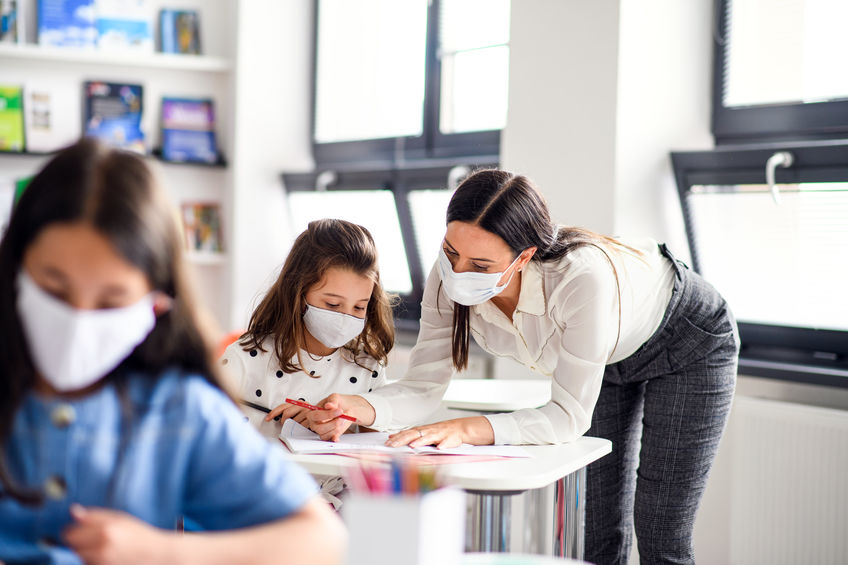Governor Doug Ducey today announced work to ensure schools remain open and we keep students in the classroom, including, launching the Open for Learning Recovery Benefit portal for parents of kids whose schools or classrooms have temporarily shifted to full remote learning and working closely with the Arizona State Board of Education to get much-needed substitute teachers in the classroom.
“We are working with school leaders and educators to lower barriers and ensure our kids continue to receive vital in-person resources,” said Governor Ducey. “We’ve seen real issues around learning loss and the emotional and mental health impact for our children during the pandemic that we need to continue to address. We’re grateful for the dedication of school leaders, teachers, substitutes, parents and volunteers who have stepped up to help keep kids in the classroom.”
READ ALSO: Should we go back to the office full time?
Giving school districts greater flexibility in how they deploy substitutes is among the options now under consideration by the board, and the effort is fully supported by the Governor.
“Substitute teachers have proven to be critical during the pandemic,” said Governor Ducey. “The state shouldn’t stand in the way of getting them in our classrooms. We applaud the State Board of Education’s effort to help schools stay open for learning.”
In addition, the Open for Learning Recovery Benefit portal is now live and available for parents of kids whose schools or classrooms have temporarily shifted to full remote learning.
Addressing the needs of these parents is the motivation behind a program the Governor announced last week aimed at ensuring in-person learning remains an option for all Arizona families and students, consistent with guidance from public health experts.
These resources for families, students and schools are in addition to other tools available to address staff shortages, including federal and state funding provided to the schools, and a streamlined process for issuing emergency substitute teaching certificates.
The State Board of Education’s existing rules already allow for issuing emergency substitute certificates to individuals with a fingerprint clearance card and a minimum of a high school degree or equivalent. At its January 24 meeting, the Board will consider modifications to the Substitute Certificate and Emergency Substitute Certificate, removing administrative burdens.
The considered rulemaking changes include:
• Allowing certified substitutes to teach as long as necessary until a contract teacher is hired, removing the 120-day limit;
• Reducing the administrative burden on substitute teachers and schools by issuing emergency substitute certificates for two years, rather than one year; and
• Providing additional flexibility to move emergency substitutes throughout school systems by allowing substitutes to teach 120 days in one district, compared to 120 days at one school.
With this proposed rule change and existing flexibilities that entrust school leaders to make staffing choices that best fit their needs, Governor Ducey calls upon schools to maximize options available to them and ensure classrooms stay open.
Open For Learning Recovery Benefit Program
Further ensuring in-person learning remains an option for all Arizona families and students, applications for the Open for Learning Recovery Benefit program launch Friday.
The program, announced by Governor Doug Ducey last week, funds up to $7,000 for needs related to Arizona Department of Economic Security-approved child care, school-coordinated transportation, tutoring, school tuition and school supplies.
“We know parents are best equipped to make decisions around their child’s education — they’re the ones in the driver’s seat,” said Governor Ducey. “With the launch of the Open for Learning Recovery Benefit program, parents in Arizona will have the financial flexibility to ensure their child has access to in-person instruction without disruption if their school shuts down for even one day.”
Parents who meet the following requirements may access the program if a school closes for even one day.
• Must demonstrate that their current school or classroom has closed in-person instruction on or after January 3, 2022;
• Student may not be in an Empowerment Scholarship Account Program OR the COVID-19 Educational Recovery Benefit; and
• Household income falls at or below 350 percent of the Federal Poverty Level.
Applications for the Open for Learning Recovery Benefit program open today. Applications will be reviewed on a rolling basis. Those with the highest financial need will receive priority.
Parents seeking to apply for the Open for Learning Recovery Benefit program may apply HERE.
Record Per-Pupil Spending
Today’s announcement comes in addition to record state and federal resources provided to school districts throughout the pandemic.
More than $4 billion in Federal Elementary and Secondary School Emergency Relief (ESSER) funds have been distributed by the State to schools. These funds are currently being expended and when combined with Arizona’s Education Plus-Up Grant Program, each local education agency will have received at least $1,800 per student.
Combined federal, state and local spending has reached record levels throughout the pandemic. For the 2021-2022 school year, per-pupil funding is expected to reach $14,656 – an all-time record for Arizona.
BACKGROUND
In his 2022 State of the State Address, Governor Ducey announced plans to launch a statewide summer learning camp initiative aimed at helping Arizona kids get caught up in math, reading and civics. The Summer Learning Camp initiative will eliminate learning loss – at no cost to Arizona families – by providing students the support they need to get back on track ahead of next school year.
On January 4, Governor Ducey announced preemptive action to ensure in-person learning remains an option for all Arizona families and students, consistent with guidance from public health experts. The announcement of the Open for Learning Recovery Benefit received a positive reaction across the state and nation as many school districts scrambled to reopen. The Wall Street Journal said “Arizona Gov. Doug Ducey is showing the way” and Harris Faulkner of Fox News called the Governor’s action the “kryptonite” to teachers unions.
On December 28, 2021, Governor Ducey met with Black Mothers Forum Founder Janelle Wood and board members to discuss efforts to expand school choice in Arizona and ways to continue removing barriers for families.
On November 15, 2021, an additional $375,000 was allocated for after-school programs that help promote healthy choices and encourage social engagement among kids of rural areas and underserved communities.
On November 9, 2021, Governor Ducey announced an investment of $1.25 million to support mentorship programs for at-risk youth and training programs for parents of underrepresented families. As students faced time away from their classrooms, they missed opportunities for mentorship. The funding will help expand existing in-school mentoring as well as college and career readiness programs.
On August 18, 2021, Arizona invested $20 million to strengthen school choice opportunities for kids and families in rural communities and all areas of the state. The Arizona Transportation Modernization Grants program aimed to improve access to reliable and safe transportation for K-12 students.
On August 17, 2021, in addition to the Education Recovery Benefit program, Governor Ducey announced the Education Plus Up Grant program, aimed at boosting per pupil spending. Under the program, all district and charter schools that kept doors open for Arizona’s students and followed all state laws, would be eligible for $163 million in grant funding.
Governor Ducey also announced $64.9 million in state and federal funding for programs that improve K-12 literacy, support adult education and expand teacher professional development.
On March 3, 2021, Governor Ducey announced a data-driven plan requiring public schools to resume teacher-led, in-person instruction. The action further advocated to close the achievement gap and keep students in the classroom.




